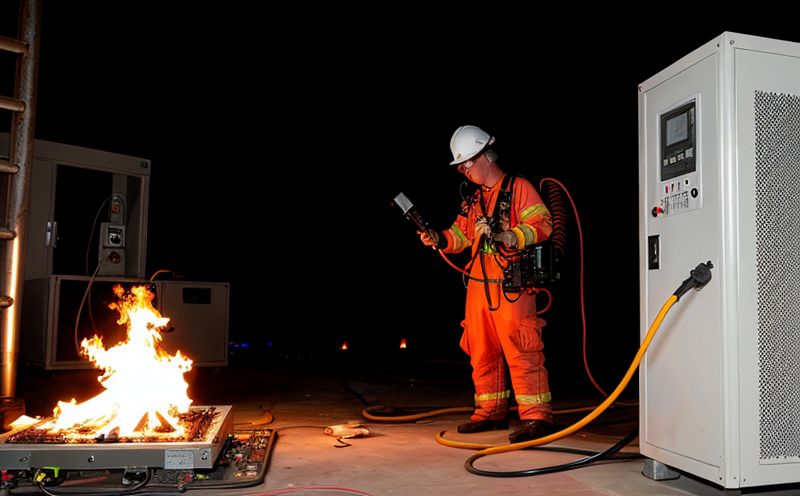Heat Release Rate Evaluation of Electrical Equipment
The heat release rate (HRR) evaluation of electrical equipment is a critical aspect of fire safety testing. HRR quantifies the amount of heat released by a material or product during combustion, which can help determine its flammability and potential risk in various environments.
Understanding HRR is essential for ensuring compliance with international standards such as ISO 56602:2013 and IEC 60695-11-4. These standards provide a framework for testing the heat release properties of materials, particularly those used in electrical and electronic equipment (EEE). The evaluation helps manufacturers and quality managers assess whether their products meet safety regulations and industry best practices.
The process involves subjecting specimens to controlled combustion conditions, typically within a Cone Calorimeter or equivalent device. This apparatus measures the heat release rate as well as other parameters like smoke production rate and mass loss rate. The data collected during these tests is crucial for understanding how materials behave under fire exposure and can inform design improvements.
For EEE, HRR evaluation is especially important because electronic components are often made from combustible materials. By conducting thorough HRR assessments early in the product development cycle, manufacturers can identify risks associated with specific materials or designs and implement changes to enhance safety without compromising functionality.
A real-world example of this process involves a manufacturer developing a new type of circuit board intended for use in high-temperature environments like data centers. Prior to full-scale production, they would subject samples of the circuit board to HRR testing using a Cone Calorimeter according to ISO 56602:2013. If initial results indicated excessive heat release or smoke generation, further refinement of the material composition might be necessary.
Accurate and reliable HRR data also supports compliance with regulatory requirements such as UL94 for plastics used in electronic devices. Ensuring that products meet these standards not only protects end users but also helps companies avoid potential legal issues related to non-compliance.
In summary, the heat release rate evaluation of electrical equipment plays a vital role in ensuring product safety and compliance with relevant international standards. It allows manufacturers to assess and mitigate fire risk early in the design process, ultimately leading to safer products for consumers.
Applied Standards
The primary standard used for heat release rate evaluation of electrical equipment is ISO 56602:2013, which specifies a method for measuring the heat release rate and other related parameters in materials and products. This standard ensures consistency across different laboratories conducting similar tests.
Additionally, IEC 60695-11-4 provides specific guidance on how to perform thermal analysis of electrical insulation systems, including HRR evaluation. Compliance with these standards is crucial for ensuring that test results are valid and can be compared internationally.
Other relevant international standards include UL94 (for plastics used in electronic devices), which sets flammability ratings based on the amount of heat released during combustion. Adhering to these standards helps guarantee product safety while meeting market demands.
Eurolab Advantages
At Eurolab, we pride ourselves on offering comprehensive fire testing services that cater specifically to the needs of our clients in various sectors. Our expertise lies not only in performing accurate and reliable HRR evaluations but also in providing valuable insights based on those results.
We employ state-of-the-art equipment such as Cone Calorimeters and other specialized apparatus designed explicitly for EEE fire testing. This ensures that all tests conducted meet the highest industry standards, giving our clients confidence in their results.
Our team of experienced professionals understands both the technical aspects of HRR evaluation and its broader implications for product safety and compliance. By leveraging this knowledge, we can offer tailored advice on how to improve your products based on test outcomes.
In addition to cutting-edge technology and skilled personnel, Eurolab also prioritizes client satisfaction through transparent communication throughout every stage of the testing process. From initial consultation to final report delivery, our goal is to ensure that you receive clear, actionable information about your product's fire performance.
Quality and Reliability Assurance
EuroLab adheres strictly to ISO/IEC 17025 standards for quality management systems in testing laboratories. This ensures that all our processes are consistent, accurate, and reliable, providing confidence in the results we deliver.
We invest heavily in maintaining up-to-date equipment and facilities, ensuring that each test conducted is performed under optimal conditions. Our commitment to continuous improvement means that we regularly update our procedures based on new developments in fire testing technology.
Client satisfaction is paramount at EuroLab; therefore, we maintain open lines of communication with every customer involved in a project. We encourage feedback and are always willing to discuss any concerns or questions you may have regarding the testing process or results.





